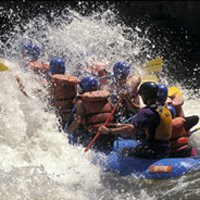River rafting is a lot of fun. Whitewater river rafting offers thrills, chills, and even an occasional spill. You'll find great river rafting rides in water from Alaska and Colorado to Peru and Fiji. While the wildest rides on many rivers are in the springtime, you can find float trips throughout the summer and early fall, and trips through stronger rapids on rivers that have dam-release water. The generally accepted international grading system puts whitewater river rafting in classes I through VI, with I being the most gentle water and VI promising the most extreme rapids.
1. River Rafting with ROW Adventures"River Rafting with Row Adventures"Row Adventures
Row Adventures offers more than 30 different trips on 13 rivers, including the Salmon and the Snake rivers in Idaho, the Missouri and Clark Fork in Montana, and the Grande Ronde in Oregon/Washington. The company also offers a trip that includes rafting, mountain biking and hiking, while overnighting at the River Dance Lodge in Idaho.
More Info2. Finding River Rafting Trip Through Rafting AmericaRafting America is a gateway Web site to 20 companies that offer river rafting trips in the United States and Canada. These companies offer half-day to multi-day trips for beginner to experts, on rivers stretching from the Snake River in Utah and the Arkansas river in Colorado, to the Gauley and New rivers in West Virginia. On the Web site's map you can click on the state where you want to go river rafting and company's names may pop up.
More Info3. River Rafting With Don Hatch River ExpeditionsDon Hatch River Expeditions focuses on rivers in the southwestern United States. Rafters can float on the Yampa River that slashes through the canyons within Dinosaur National Park, on the Green River through the Gates of Lodore or the Colorado River through Cataract Canyon.
More Info4. River Rafting the Royal Gorge with Raft MastersRafting the Royal Gorge canyon is one of the top places to go
Colorado river rafting. There is no better way to go
royal gorge rafting afting with one of the best rafting companies in the US; Raft Masters. As the Arkansas River narrows to only 25-feet wide, this adventure-packed whitewater rafting trip winds its way through the 1,100-foot cliffs of the Royal Gorge. Famous for its steep drops, huge waves, and continuous Class III to Class V whitewater, the spectacular scenery and Royal Gorge's famous rapids thrill even the most experienced whitewater rafting veterans.
More Info5. River Rafting the Lehigh Gorge with Pocono WhitewaterPocono Whitewater offers three Lehigh Gorge river rafting trips. The company also offers combination packages, such as Battles & Paddles, which includes a rafting trip and an evening of paintball at Skirmish "Castle Night" event. Another choice is mountain biking the Lehigh Gorge and rafting the Lehigh River.
More Info6. Wilderness Aware Offers Whitewater River Rafting in Colorado and ArizonaThis company, twice named "Colorado Company of the Year," offers raft trips on the Platte, the Delores and the Colorado rivers in Colorado, and the Salt river in Arizona.
7. Some Multi-sport Trips With Austin-Lehman Adventures Include River RaftingAustin-Lehhman Adventures offers a variety of adventure trips and many include river rafting.
8. River Rafting With Nantahala Outdoor CenterThis company runs river rafting trips on nine rivers in Tennessee, Georgia and North Carolina.
9. River Rafting with OarsOars offers more than 20 new and classic river rafting trips, in locales from Alaska to Fiji. The company also offers multi-sport trips, such as rafting the Apurimac River, the source of the Amazon and taking a lodge to lodge trek to Machu Picchu.
More Info10. River Rafting the Grand Canyon With Arizona River RunnersArizona River Runners offers multi-day river rafting trips on the Colorado River through the Grand Canyon. The company offers a selection of 3- to 8-day motorized adventures and 6- to 13-day oar-powered trips, which can include hiking in or out of the Grand Canyon.
More Info
